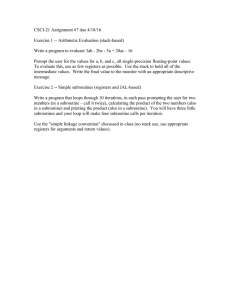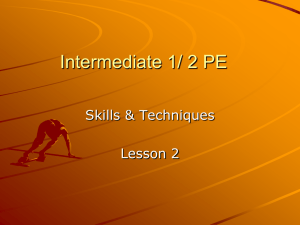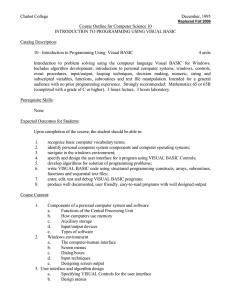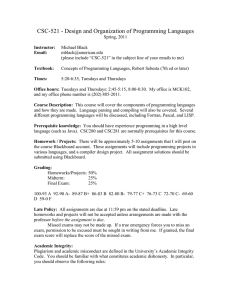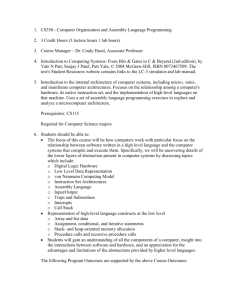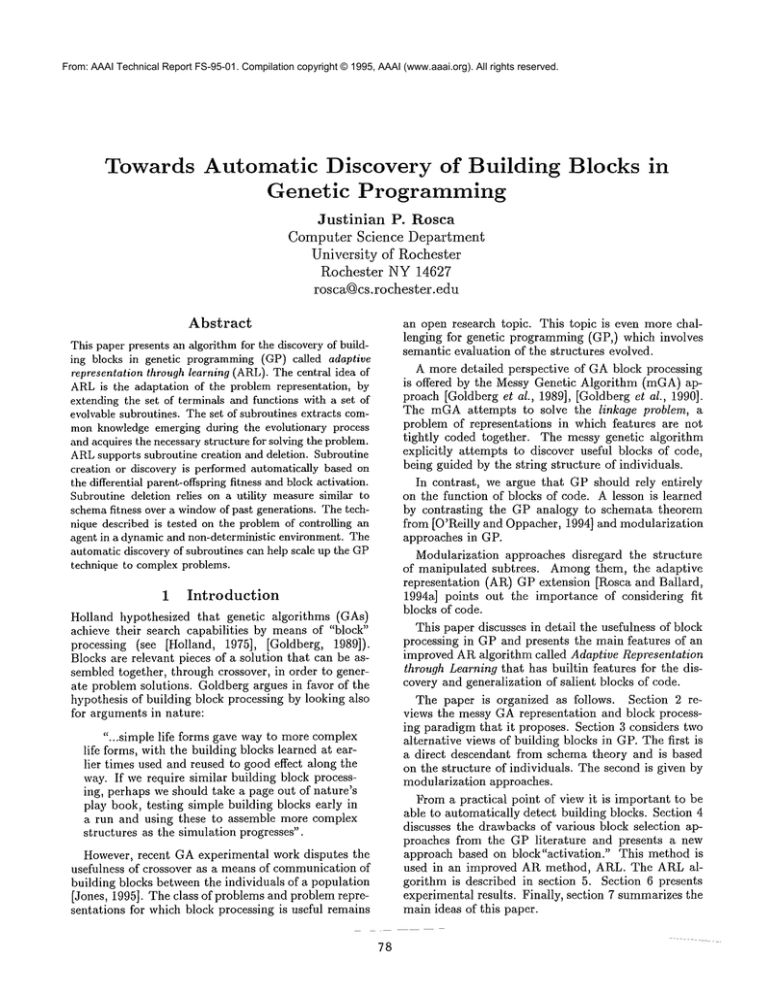
From: AAAI Technical Report FS-95-01. Compilation copyright © 1995, AAAI (www.aaai.org). All rights reserved.
Towards Automatic Discovery
of Building
Genetic
Programming
Blocks
in
Justinian
P. Rosea
Computer Science Department
University of Rochester
Rochester
NY 14627
rosca@cs.rochester.edu
Abstract
an open research topic. This topic is even more challenging for genetic programming (GP,) which involves
semantic evaluation of the structures evolved.
A more detailed perspective of GAblock processing
is offered by the Messy Genetic Algorithm (mGA)approach [Goldberg et al., 1989], [Goldberg et al., 1990].
The mGAattempts to solve the linkage problem, a
problem of representations in which features are not
tightly coded together. The messy genetic algorithm
explicitly attempts to discover useful blocks of code,
being guided by the string structure of individuals.
In contrast, we argue that GP should rely entirely
on the function of blocks of code. A lesson is learned
by contrasting the GP analogy to schemata theorem
from [O’Reilly and Oppacher, 1994] and modularization
approaches in GP.
Modularization approaches disregard the structure
of manipulated subtrees. Amongthem, the adaptive
representation (AR) GP extension [Rosca and Ballard,
1994a] points out the importance of considering fit
blocks of code.
This paper discusses in detail the usefulness of block
processing in GPand presents the main features of an
improved ARalgorithm called Adaptive Representation
through Learning that has builtin features for the discovery and generalization of salient blocks of code.
The paper is organized as follows. Section 2 reviews the messy GArepresentation and block processing paradigm that it proposes. Section 3 considers two
alternative views of building blocks in GP. The first is
a direct descendant from schema theory and is based
on the structure of individuals. The second is given by
modularization approaches.
From a practical point of view it is important to be
able to automatically detect building blocks. Section 4
discusses the drawbacks of various block selection approaches from the GP literature
and presents a new
approach based on block"activation."
This method is
used in an improved AR method, ARL. The ARLalgorithm is described in section 5. Section 6 presents
experimental results. Finally, section 7 summarizesthe
main ideas of this paper.
This paper presents an algorithm for the discoveryof building blocks in genetic programming(GP) called adaptive
representation through learning (ARL).The central idea
ARLis the adaptation of the problem representation, by
extending the set of terminals and functions with a set of
evolvable subroutines. The set of subroutines extracts commonknowledge emerging during the evolutionary process
and acquires the necessarystructure for solving the problem.
ARLsupports subroutine creation and deletion. Subroutine
creation or discovery is performed automatically based on
the differential parent-offspringfitness and block activation.
Subroutine deletion relies on a utility measuresimilar to
schemafitness over a windowof past generations. The techuique described is tested on the problemof controlling an
agent in a dynamicand non-deterministic environment. The
automatic discovery of subroutines can help scale up the GP
technique to complexproblems.
1 Introduction
Holland hypothesized that genetic algorithms (GAs)
achieve their search capabilities by means of "block"
processing (see [Holland, 1975], [Goldberg, 1989]).
Blocks are relevant pieces of a solution that can be assembled together, through crossover, in order to generate problem solutions. Goldberg argues in favor of the
hypothesis of building block processing by looking also
for arguments in nature:
"...simple life forms gave way to more complex
life forms, with the building blocks learned at earlier times used and reused to good effect along the
way. If we require similar building block processing, perhaps we should take a page out of nature’s
play book, testing simple building blocks early in
a run and using these to assemble more complex
structures as the simulation progresses".
However, recent GAexperimental work disputes the
usefulness of crossover as a means of communicationof
building blocks between the individuals of a population
[Jones, 1995]. The class of problems and problem representations for which block processing is useful remains
78
2 The Messy Genetic
Algorithm
In standard GAsit is hard to get the right combination
of alleles for blocks with high defining length or high
order. Moreoverit is hard to preserve them in the population in order to combine them with other building
blocks. Last but not least, it is more difficult to combine building blocks whosebit positions are interleaved,
based on fixed crossover operators and the mutate operator. Solving these problems would enable solving
bounded deceptive problems [Goldberg, 1989], and, in
general, the linkage problem defined above.
To solve such problems, an mGAencodes objects as
variable length strings with position independent genes.
Each gene is tagged with an index representing its original position. A basic assumption is that the mapping
from tag sets to building blocks is unknown,i.e. a partitioning of the set of string bit positions that corresponds
to building blocks is not given initially.
An toGA attempts the building block processing
problem by decomposing the search problem into three
steps. First, the initialization phase generates all possible substrings of length k. A better alternative to
generating useful combinations of alleles is the probabilistically complete initialization discussed in [Goldberg et al., 1993]. Second, proportions of good substrings are increased and new substrings are generated
by gene deletion operations. In order to evaluate substrings, the missing positions of the substring are filled
with the bit values taken from a competitive template
(see figure 1). Third, a standard GAis run to juxtapose the already detected good building blocks. The
GAuses two special genetic operators, cut and splice.
Cut generates two individuals from a parent by cutting
the parent at a randomly chosen position. Splice concatenates two strings into one. Besides, the mutation
operator may also be used.
fitness value better than that of the competitive template are candidate building blocks at that level. A
greedy procedure is used to generate such templates.
Prior domain knowledge may also be used in this process.
The mGAraises two problems and offers possible
solutions to them: (1) evaluation of a block or partially defined string, and (2) population enrichment
with salient blocks. Oncesalient blocks are separately
created on the basis of procedures for (1) and (2), it
hoped that the mechanics of GAcrossover eventually
combines the locally optimal blocks and speeds up the
genetic search process.
3 Building
Blocks
in GP
3.1
Structural
Approach
The above discussion of the mGArepresentation points
out the explicit role of the structure of an individual in
a genotype encoding as well as the idea of block evaluation. The analysis of schemata in GAprocessing also
relies on the structure of an individual. It is natural
to question whether structure information could provide hints in the analysis of building blocks in genetic
programming.
A GP analogy along the lines of GA schemata theory and GA building block hypothesis has been attempted in [O’Reilly and Oppacher, 1994]. The main
goal was understanding if GP problems have building
block structure and when GPis superior to other search
techniques. Next, we overview this analysis.
A GP schema was defined to be a collection
of
tree fragments [Koza, 1992]. This intuitive definition
was generalized to a collection of trees possibly having subtrees removed [O’Reilly and Oppacher, 1994].
An individual instantiates
a schema in case it "covers" (matches) all the fragments. Overlappings between
fragments are not allowed.
The probability of tree disruption by crossover was
estimated based on this latter definition. A couple of
problems specific to GPhad to be overcome. First, subtrees are free to moveanywhere in a tree structure as
a result of crossover. Multiple copies of a subtree can
appear within the same individual, so that instances of
a tree fragment should be counted. A count value, representing the number of appearances of that fragment
in a tree, is attached to each schema fragment. Second,
the notion of schemaorder or specificity changes. Specificity is a relative measure,as the size of GPindividuals
is variable.
A characterization of schemaprocessing was difficult
in the structural approach offered by the GP schema
definition. [O’Reilly and Oppacher, 1994] conclude that
schema processing, as defined, does not offer an appropriate perspective for analyzing GP.
A structural approach is also at the basis of "constructional problems" [Tackett, 1995], i.e. problems
in which the evolved trees are not semantically evaluated. Instead, tree fitness is based on the decomposi-
Populationstring: ((I O) (4 O) (5 1)
Competitivetemplate
Figure 1: In order to evaluate a partially defined string
(top), an mGA
uses a template (bottom) that is a locally
optimal structure and is namedcompetitive template. The
string elementsare pairs of the form (index-tag, allele).
A string can be chosen as a competitive template for
level k when it is optimal, i.e. no k bit changes can
improve its fitness. Thus, a competitive template is a
locally optimal structure. Only strings that achieve a
79
tion into target expressions, similar to the generalized
GP schelna, to which are assigned fitness values. By
ignoring the semantic evaluation step, the analysis of
constructional problems is not generalizable to GP in
general.
Functional
Approach
3.2
A GP structural theory analogous to GAschemata theory, as attempted in [O’Reilly and Oppacher, 1994]
side-stepped the functional role of the GP representation. In contrast, modularization approaches take a
functional perspective. Modularization addresses the
problems of inefficiency and scaling in GP. Modularization approaches consider the effect of encapsulating and
eventually generalizing blocks of code.
Three main approaches to modularization, discussed
in the GP literature,
are automatically defined functions (ADFs) [Soza, 1992], module acquisition (MA)
[ingeline, 1994b] and adaptive representation (AR)
[Rosca and Ballard, 1994a].
A first approach to modularization was the idea of encapsulation or function definition, introduced in [Koza,
1992]. The encapsulation operation, originally called
"define building block" was viewed as a genetic operation that identifies a potential useful subtree and gives it
a nameso that it can be referenced and used later. Encapsulation is a particular form of function definition,
with no arguments. In general, a function or subroutine
is a piece of code that performs commoncalculations
parameterized by one or more arguments.
[Koza, 1992] also introduced the idea of automatic
function definition. Ill this approach each individual program has a dual structure.
The structure is
defined based on a fixed number of components or
branches to be evolved: several function branches,
also called automatically defined functions, and a main
program branch. Each function branch (for instance
ADFo, ADF1) has a fixed number of arguments. The
main program branch (Program-Body) produces the
result. Each branch is a piece of LISP code built out
of specific primitive terminal and function sets, and
is subject to genetic operations. The set of functiondefining branches, the number of arguments that each
of the function possesses and the "alphabet" (function
and terminal sets) of each branch define the architecture
of a program.
GP has to evolve the definitions of functions with a
fixed number of arguments and a value-returning expression (main program) that combines calls to these
functions. During evolution, only the fitness of the complete program is evaluated.
Genetic operations on ADFsare syntactically constrained by the components on which they can operate.
For example, crossover can only be performed between
subtrees of the same type, where subtree type depends
on the function and terminal symbols used in the deftnition of that subtree. An example of a simple typing
rule for an architecturally uniform population of pro8O
grams is branch typing. Each branch of a program is
designated as having a distinct type. In this case the
crossover operator can only swap subtrees from analogous branches.
The second approach to modularization is called
module acquisition ([Angeline, 19945], [Angeline,
1994a]). A module is a function with a unique name defined by selecting and chopping off branches of a subtree
selected randomly from an individual. The approach
uses the compression operator to select blocks of code
for creating new modules, which are introduced into a
genetic library and may be invoked by other programs
in the population. Twoeffects are achieved. First the
expressiveness of the base language is increased. Second modules become frozen portions of genetic material, which are not subject to genetic operations unless
they are subsequently decompressed.
The third approach is called Adaptive Representation
(AR) [Rosca and Ballard, 1994a]. The basic idea is
automatically extract commonknowledge in the form
of subroutines that extend the problem representation.
ARexplicitly attempts to discover new good functions
or subroutines, based on heuristic criteria in the form of
domain knowledge. Good subroutines would represent
building blocks in GP.
In order to control the process of subroutine discovery, ARkeeps track of small blocks of code appearing in
the population. A key idea is that although one might
like to keep track of blocks of arbitrary size, only monitoring the merit of small blocks is feasible. Useful blocks
tend to be small. Blocks are generalized to subroutines
([Rosca and Ballard, 19945]) and the process can
applied recursively to discover more and more complex
useful blocks and subroutines. Newly discovered subroutines dynamically extend the problem function set.
Consequently, ARtakes a bottom-up approach to subroutine discovery and evolves a hierarchy of functions.
At the basis of the function hierarchy lie the primitive functions from the initial function set. More complex subroutines are dynamically built based on the
older functions, adapting the problem representation
(see Figure 2).
Discovered functions or function-defining branches
will be called subroutines in the rest of the paper.
4 Block Selection
Existent
Approaches
4.1
MArandomly selects a subtree from an individual and
randomly chops its branches to define a module and
thus decide what part of genetic material gets frozen.
ADFsamples the space of subroutines by modifying automatically defined functions at randomly chosen crossover points. This may not be a good strategy
due to the the non-causality problem of ADF[Rosca
and Ballard, 1995]. The causality perspective analyzes
how natural or smooth perturbations of solutions can
be generated through crossover and are advantageous.
Non-causality relates small changes in the structure of
"nrnc
c
b
CURRF~N~I"
POPULATION
based on block fitness. Determining fit or salient blocks
of code is a critical problem. Whatis a salient block of
code and how can it be used to define new subroutines?
In AR, the elements of the hierarchy of subroutines
are discovered by using either heuristic information as
conveyed by the environment or statistical
information
extracted from the population. The heuristics are embedded in block fitness functions which are used to determine fit blocks of code. The hierarchy of subroutines
evolves as a result of several steps:
SOLUTION
. "~
f
DF4
/
~
,
DF3
~
DF5
~
a
1. Select candidate building blocks from fit small blocks
appearing in the population
2. Generalize candidate blocks to create new subroutines
Figure 2: A hypothetical call graph of the extended flmction set in the ARmethod. The primitive function set is
extended hierarchically with subroutines (DF1, DF2,etc.)
discoveredat generation numbersa, b, c.
3. Extend the representation
a parse tree with drastic effects of such changes on the
properties or behavior of the individual (such as the
results or side effects of executing the function represented by the parse tree). Causality, or smooth behavior change in response to small genotypic changes (also
called strong causality), would be needed in late stages
of evolution for tuning evolved structures.
However, ADFdoes not appear to favor such fine adjustments. In most cases, crossover changes in either a
subroutine or the result producing branch of an individual create an offspring with a totally changed behavior.
For example, a change in a subroutine at the basis of the
hierarchy of ADFsis amplified through the hierarchy of
calls drastically changing the individual behavior. Similarly, a change in the result producing branch mayalso
determine a drastical change in behavior. Due to lexical scoping for ADFcalls, calls to ADFsfrom the other
parent will nowrefer to local and potentially different
subroutines, drastically changing the semantics of the
individual program. Such non-causal changes may determine a loss of beneficial evolutionary changes. ADF
counteracts the non-causality effect at some waste in
computational effort by employing a bottom-up stabilization of subroutines. Also, the implicit biases of GP
search (regarding expected height of crossover points,
position of subtrees involved in crossover, effective code
and structure exploitation in GP) alleviate the problem
[Rosca and Ballard, 1995]. Early in the process changes
are focused towards the evolution of more primitive
functions. Later in the process the changes are focused
towards the evolution of programcontrol structures, i.e.
at higher levels in the hierarchy.
The search control structure of ARexplicitly favors
the bottom-up definition of a hierarchy of subroutines.
In contrast to uninformed or random manipulation of
blocks of code as in ADF, AR takes an informed or
heuristic approach to sift through all new blocks of code
81
with the new subroutines.
The generation intervals with no function set changes
represent evolutionary epochs. At the beginning of each
new epoch, part of the population is extinguished and
replaced with random individuals built using the extended function set [Rosca and Ballard, 1994a]. The
extinction step was introduced in order to make use of
the newly discovered subroutines.
Evaluation should be based on additional domain
knowledge whenever such knowledge is available. However, domain-independent methods are more desirable
for this goal. Unfortunately, simply considering the frequencyof a block in an individual [Tackett, 1993], in the
population [Rosea and Ballard, 1994c], the block’s constructional fitness or schemafitness [Altenberg, 1994] is
not sufficient.
Constructional fitness takes into account the proliferation rate of the block within the population. However,
such a measure has inherent drawbacks. First, constructional fitness is biased due to the extremely small
population sizes considered [O’Reilly and Oppacher,
1994]. Second, it is computationally expensive to keep
track of all possible blocks of code and block frequency
can be misleading [Rosca and Ballard, 1994a]. Third, a
block of code mayrarely have a stationary distribution
in its effects on the fitness of programs, a necessary condition to makeconstructional fitness useful [Altenberg,
1994].
Schemafitness, also called conditional expected fitness of a block [Tackett, 1995] is the average fitness of
all the members of the population which contain the
block. Tackett performs an off-line analysis of conditional fitness. Problems encountered when considering
block frequency appear again when trying to determine
saliency based on conditional fitness: salient traits have
high conditional fitness but high fitness does not necessarily imply salience.
ARLdiscovers potential salient blocks of code based
on two notions, differential offspring-parent fitness and
"active" blocks. These notions are presented next.
The method requires that each node have an associated counter recording its number of executions but
does not necessitate additional effort in an interpreted
GP system.
In contrast to [Tackett, 1995], salient blocks have to
be detected efficiently, on-line. Consequently, candidate blocks are only searched for amongthe blocks of
small height (between 3 and 5 in the current implementation) present in the population. This is done by using
a record of the dynamics of the population. Only new
blocks created through crossover are examined. All new
blocks can be discovered in O(M) time, where Mis the
population size, by marking the program-tree paths actually affected by GP crossover and by examining only
those paths while searching for new blocks [Rosca and
Ballard, 1994a].
Nodes with the highest activation value are considered as candidates. In addition, we require that all
nodes of the subtree be activated at least once or a
minimumpercentage of the total number of activations
of the root node. This condition is imposed in order to
eliminate from consideration blocks containing introns
(for a discussion of introns in GPsee [Nordin et al.,
1995]) and hitch-hiking phenomena[Tackett, 1995].
Figure 3: Differential fitness distributions over a run of GP.
4.2
Differential
Fitness
Global measures such as the population diversity or local measuressuch as the differential fitness from parents
to offspring can be used to guide the creation of new
subroutines. ARLrelies both on global and local information implicitly stored in the population to determine
the utility of blocks of code.
First, blocks of code are selected from programs (i)
with the highest difference in fitness:
StdFitness(i)
- rninpcParents(i)
5 Adapting
5.1
Representation
Learning
through
ARL Strategy
The central idea of the ARLalgorithm is the dynamic
adaptation in the problem representation.
The problem representation at generation t is given by the union
of the terminal set 7-, the function set ~r, and a set of
evolved subroutines St. 7- and ~ represent the set of
initial primitives and are fixed throughout the evolutionary process. In contrast, St is a set of subroutines
whose composition may vary from one generation to
another. The intuition is that an alteration of the composition of St may dramatically change the search behavior of the GP algorithm. For example, the inclusion
of more complexsubroutines, that turn out to be part of
a final solution, will result in less computational effort
spent during search for the creation of good candidate
solutions and will speed up search. The ARLalgorithm
attempts to automatically discover useful subroutines
and grow the set St by applying the heuristic "pieces of
useful code may be generalized and successfully applied
in more general contexts."
St may be viewed as a population of subroutines that
extends the problem representation in an adaptive manner. Subroutines compete against one another but may
also cooperate for survival. Newsubroutines are born
and the least useful ones die out. St is used as a pool
of additional problem primitives, besides 7- and ~r for
randomly generating individuals in the next generation,
t+l.
{ StdFitness(p)
High differences in fitness are presumably created by
useful combinations of pieces of code appearing in the
structure of an individual. This is exactly what the
algorithm should discover. Figure 3 shows a 3D histogram of the differential fitness defined above for a
run of Even-5-Parity. Each slice of the 3D plot for
a fixed generation represents the number of individuals in a population of size 4000 for which the differential fitness has a given value. The figure suggests
that a small number of individuals improve on the fitness on their parents (the right of the "neutral wall" for
DeltaFitness = 0). ARLwill focus on such individuals
in order to discover salient blocks of code.
4.3
Block Activation
Program fitness is calculated as a result of program
evaluation. In some applications a program is evaluated on a set of fitness cases. In other applications the
same program has to be evaluated a number of times on
the same problem instance. During repeated program
evaluation, some blocks of code are executed more often than others. The active blocks become candidate
blocks. Block activation is defined as the number of
times the root node of the block is executed. Salient
blocks are active blocks of code that prove to be useful.
82
5.2
Discovery
of Subroutines
Newsubroutines are created using blocks of genetic material from the pool given by the current population.
The major problem here is the detection of what are
salient, or useful, blocks of code. The notion of usefulness in the subroutine discovery heuristic relies on the
idea of tracking active pieces of code, as described before. Useful active code is generalized and transformed
into useful subroutines.
Each block of code finally selected from a population individual is transformed into a subroutine through
inductive generalization. Generalization replaces some
randomsubset of terminals in the block with variables.
Variables become formal arguments of the subroutine
created. This operation makes sense in the case when
the closure condition is satisfied by the sets of terminals and functions. In typed GP [Montana, 1994], each
terminal selected for generalization will have a certain
type. The type is inherited by the variable introduced
in the corresponding place. Thus, the type information
of all the variables introduced and the type of the block
root node will define tile signature of the new subroutine.
Note that the method of discovering building blocks
and creating new subroutines based on simple blocks of
code is applied recursively so that subroutines of any
complexity can be discovered.
Newsubroutines created in a generation are added
to ,St. St is used to randomly generate new individuals that enter the fitness proportionate selection competition in the current population. Each subroutine is
assigned an utility value that averages the fitness of all
individuals that invoke it. The subroutine utility is updated using a running average formula over successive
generations. Lowutility subroutines are deleted in order to make room to newly discovered subroutines. The
code of deleted subroutines is substituted in all places
where the subroutine is invoked.
6 Experimental
¯ All the action primitives nowreturn the distance from
the corresponding element.
¯ Wehave introduced relational ( <, =, >= ), logical
operators ( and, or, not ), and random integer constants representing distance and direction.
¯ The iflte function was replaced by an if-then-else
function, ifte, which tests its condition and executes
either its then or its else branch.
The GP system uses point typing in the random generation of programs and in crossover operations under
this new representation B (see Table 1). The goal was
to evolve programs that express explicit conditions under which certain actions are prescribed, as opposed to
the non-causal representation in [Koza, 1992] which creates programs that encode state information and rely
on side-effects.
The typed representation takes into account the signature of each primitive, i.e. the return type of each
function as well as the types of its arguments. It facilitates the evolution of explicit logical conditions under
which actions can be executed.
Table 1: Signatures of functions (type of result and argument types) in the typed Pac-Manrepresentation.
[ Function
ifb
ifte
I
rand-dis
rand-direct
and
not
or
l Type [ #Arg
act
2
act
3
dis
0
direct
0
Description
if monsters blue
if-then-else
random dis.
random direct.
bool, bool
bool
bool, bool
dis, dis
direct, direct
<
Results
[ Arg. Types
actj act
bool, act, act
] sense-dis-food
[ dis
sense dis.
I act-a-pill
[ act
move to closest
to food
pill
6.2
ARL Runs
Weexamined the ability of the ARLalgorithm to discover useful subroutines and to use them in a beneficial way for generating problem solutions. Wealso
compared ARLwith standard GP using the problem
representation from [Koza, 1992]. In all experiments
the population size was 500 and the algorithm was run
for 100 generations. The size of the set of subroutines
was 10. Other GP parameters were chosen as in [Koza,
199451.
Table 2 shows a sample of results for the best solutions obtained using standard GP, ARLand by hand
coding.
The best-of-generation
program evolved by ARLfor
run number 3 is extremely modular, relying on 6 useful subroutines. Only one of the subroutines is reused
a second time. All the others are invoked once only.
However,all six subroutines are effective in guiding the
6.1 Test Case
We have tested the ARLalgorithm on the problem of
controlling an agent in a dynamic environment, similar to the Pac-Manproblem described in [Koza, 1992]).
The problem is to evolve a controller to drive the agent
(Pac-Man) in a dynamic and non-deterministic
world
in order to acquire the maximumreward. A partial solution to the problem is a program involving decisions
of what actions to take in every resulting world state.
Pac-Man is complex discrete-time,
discrete-space
problem. Koza describes a GP implementation to the
Pac-Man problem, that involves a high enough problem
representation so as to focus on a single game aspect,
that of task prioritization [Koza, 1992]. Call this representation A.
We have extended and changed representation A in
three ways:
83
18,000.0
3.5
16,000,0
3.0
14,000.0
16,000.0
- 3_5
14,000.0
3.0
12,000.0
io,ooo.o
o.
" 4.0
2.5
12,000.0
ft.
18,000.0
8,00o.o
o
1.5 Iii
6,000.0
2.5
m,ooo.o
2.0
,,
8.~o.o
g
6,000.0
[
2.0
o
ks ’"
1.0
4,000.0
0.5
2,000.0
0.0
0 l0
20
30
40
50
60
70
80
0.0
90
4,000.0
1.0
2,000.0
0.5
0.0
0.0
0
Generation
10
20
30
40
50
60
70
Generation
Figure 4: Variation of the numberof hits, average fitness
and entropy for solution I (GP).
Figure 5: Variation of the numberof hits, average fitness
and entropy for solution 2 (ARL).
Pac-Man for certain periods of time. Amongthe six
subroutines, two parameterless subroutines appear to
be extremely interesting. One is successfully used for
attracting monsters:
(ifte (< (sense-dis-fruit)
50)
(act-a-fruit)(act-a-mon-1))
The second is used for carefully advancingto the pill.
It’s simplified code is:
(if (= (sense-direct-mon-1)
(sense-direct-pill))
(act-r-mort-i)
(act-a-pill))
Figures 4 and 5 compare the evolutionary process for
GP (solution 1) and ARL(solution 3). ARLmaintains
a high diversity (measured as entropy, see [Rosca, 1995])
due to the discovery and use of new subroutines and is
able to discover better solutions muchfaster.
GPsolutions have poor generalization capability but
this may not be surprising taking into account that the
environment is non-deterministic. However,this is also
the case with humandesigned solutions which are written so that they apply in the most general case (see
solution 4 in table 2). Solutions obtained with ARLappear to be very interesting. They perform much better
than the ones evolved by means of GP or hand-coded,
and they are also evolved faster. The GPtraces clearly
show the reach of local minima.
Table 2: Comparisonbetweensolutions obtained with standard GP and ARLand a carefully hand designed program. Each solution has been tested on 100 different randora seeds simulating a non-deterministic environment. The
table showsthe ma.-dmum
numberof points, average, standard deviation, and numberof cycles of programexecution
until the agent is eaten by Pac-Man.
[ Run[ Algorithm[ Rep[ Max[ Avg[ Std.Dev.[ Cycles [
1
2
3
4
GP
ARL
ARL
Hand
A
A
B
B
5720
14640
9200
S560
2400
2568
2930
2736
150
308
290
323
121
1
136
151
7 Conclusions
Weproposed an improved version of the ARapproach
called adaptive representation through learning (ARL).
ARLcombines competition between individuals in a
population of programs with cooperation between individuals in a population of evolvable subroutines. ARL
does not require explicit block fitness functions. It evaluates blocks of code from highly improved offspring
based on block activation.
GP and ADF are based on a "blind" competition
between individuals. In contrast, in ARL, the population of subroutines extracts commonknowledge that
emerges during the evolutionary process. Subroutines
beneficial to some individuals could be invoked also by
other individuals. The end result is the collection of
subroutines that acquires the necessary structure for
solving the problem. It takes the form of a hierarchy of
subroutines as in figure 2. The population of subroutines evolves through creation and deletion operations.
The ARLextension to GP maintains a fixed size population of programs(partial solutions) and a fixed size
population of discovered subroutines. Subroutines are
cumulatively rewarded for each invocation from newly
created programs or other subroutines. They also compete for existence in the function set. The population
of subroutines evolves slowlier than the population of
programs.
Weplan to experiment with duplication and mutation operations on the population of subroutines. The
duplication operations are causal [Rosca and Ballard,
1995] and should have exploitative role, by increasing
the potential for specialization or generalization of the
behavior of programs, similarly to the creation and addition of ADFoperations described in [Koza, 1994a].
The mutation operator will have an exploitative role
and enable the evolution of the set of functions. It
would determine the creation of new population individuals that would invoke the newly created functions.
A more thorough comparison among solutions obtained using the GP, ADFand ARLalgorithms is undergoing.
[Koza, 1994a] John R. Koza, "Architecture-Altering
Operations for Evolving the Architecture of a MultiPart Program in Genetic Programming," Computer
Science Department STAN-CS-TR-94-1528, Stanford University, 1994.
[Koza, 1994b] John R. Koza, Genetic ProgrammingII,
MIT Press, 1994.
[Montana, 1994] David J. Montana, "Strongly Typed
Genetic Programming," Technical Report 7866,
BBN, 1994.
[Nordin et al., 1995] Peter Nordin, Frank Francone,
and Wolfgang Banzhaf, "Explicitly defined introns
and destructive crossover in genetic programming,"
Technical Report NRL2, Univ. of Rochester, June
1995.
[O’Reilly and Oppacher, 1994] Una-MayO’Reilly and
Franz Oppacher, "The troubling aspects of a building block hypothesis for genetic programming," In
Proceedings of the Third Workshop on Foundations
of Genetic Algorithms. Morgan Kaufmann Publishers, Inc, 1994.
[Rosca, 1995] Justinian P. Rosca, "Entropy-Driven
Adaptive Representation,"
In Proceedings of the
Workshop: Genetic Programming: From Theory to
Real World Application, the Twelfth International
Conference on Machine Learning, pages 23-32. Univ.
of Rochester, June 1995.
[Rosca and Ballard, 1994a] Justinian P. Rosca and
Dana H. Ballard, "Genetic Programming with Adaptive Representations," Technical Report 489, University of Rochester, Computer Science Department,
February 1994.
[Rosca and Ballard, 1994b] Justinian P. Rosca and
Dana H. Ballard, "Hierarchical Self-Organization
in Genetic Programming,"
In Proceedings of
the Eleventh International Conference on Machine
Learning, pages 251-258. Morgan Kaufinann Publishers, Inc, 1994.
[Rosca and Ballard, 1995] Justinian P. Rosca and
Dana H. Ballard, "Causality in Genetic Programming," Proceedings of the Sixth International Conference on Genetic Algorithms (ICGA95), 1995.
[Rosca and Ballard, 1994c] Justinian P. Rosca and
Dana H. BMlard, "Learning by Adapting Represenrations in Genetic Programming," In Proceedings of
the IEEE World Congress on Computational InteUigence, pages 407-412. IEEE Press, Orlando, 1994.
[Tackett, 1993] Walter Alden Tackett, "Genetic Programming for Feature Discovery and Image Discrimination," In Proceedings of the Fifth International
Conference on Genetic Algorithms. Morgan Kaufmann Publishers, Inc, 1993.
[Tackett, 1995] Walter Alden Tackett, "Mining the Genetic Program," IEEE Expert Magazine, June 1995.
References
[Altenberg, 1994] Lee Altenberg, "The Evolution of
Evolvability in Genetic Programming," In Kim Kinnear, editor, Advances in Genetic Programming. MIT
Press, 1994.
[Angeline, 1994a] Peter J. Angeline, Evolutionary Algorithms and Emergent Intelligence,
PhD thesis,
Computer Science Department, Ohio State University, 1994.
[Angeline, 1994b] Peter J. Angeline, "Genetic Programming and Emergent Intelligence,"
In Kim Kinnear, editor, Advances in Genetic Programming. MIT
Press, 1994.
[Goldberg, 1989] David E. Goldberg, Genetic Algorithms in Search, Optimization, and Machine Learning, Addison-Wesley, 1989.
[Goldberg et al., 1993] David E. Goldberg, Kalyanmoy
Deb, and Bradley Korb, "Rapid, Accurate Optimization of Difficult Problems Using Fast Messy Genetic Algorithms," In Proceedings of the Fifth Inter;
national Conference on Genetic Algorithms. Morgan
KaufmannPublishers, Inc, 1993.
[Goldberg et al., 1989] David E. Goldberg, Bradley
Korb, and Kalyanmoy Deb, "Messy Genetic Algo.
rithms: Motivation, Analysis, and First Results,"
Complex Systems, 3:493-530, 1989.
[Goldberg et al., 1990] David E. Goldberg, Bradley
Korb, and Kalyanmoy Deb, "Messy Genetic Algorithms Revisited: Studies in Mixed Size and Scale,"
Complex Systems, 4:415-444, 1990.
[Holland, 1975] John H. Holland, Adaptation in Natural and Artificial Systems, An Introductory Analysis
with Applications to Biology, Control and Artificial
Intelligence, The University of Michigan, 1st edition,
1975.
[Jones, 1995] Terry Jones, "Crossover, Macromutation and Population-Based Search," Proceedings of
the Sixth International Conference on Genetic Algorithms (ICGA95), pages 73-80, 1995.
[Koza, 1992] John 1%. Koza, Genetic Programming: On
the Programming of Computers by Means of Natural
Selection, MITPress, 1992.
85

